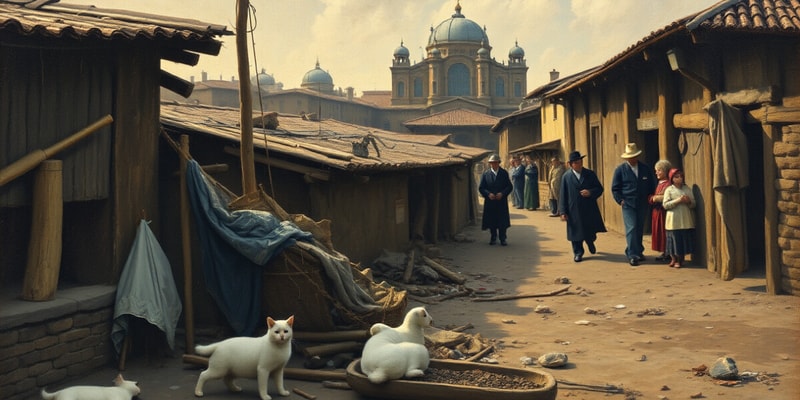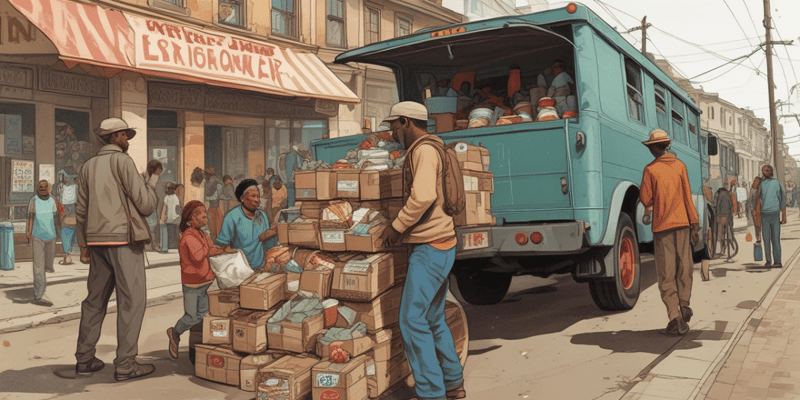Podcast
Questions and Answers
What defines absolute poverty?
What defines absolute poverty?
Which group is categorized as 'the working poor'?
Which group is categorized as 'the working poor'?
How does the political structure affect the impoverished?
How does the political structure affect the impoverished?
Which of the following is a characteristic of the homeless population?
Which of the following is a characteristic of the homeless population?
Signup and view all the answers
What is one way that government programs tend to support the upper and middle classes?
What is one way that government programs tend to support the upper and middle classes?
Signup and view all the answers
Which of the following best describes relative poverty?
Which of the following best describes relative poverty?
Signup and view all the answers
What is the official poverty level based on?
What is the official poverty level based on?
Signup and view all the answers
Which group primarily benefits from government programs according to the content?
Which group primarily benefits from government programs according to the content?
Signup and view all the answers
What structural factors contribute to poverty as mentioned in the content?
What structural factors contribute to poverty as mentioned in the content?
Signup and view all the answers
What characterizes the condition of the homeless population?
What characterizes the condition of the homeless population?
Signup and view all the answers
Study Notes
Understanding Poverty
- Poverty is characterized by insufficient income to meet basic necessities: food, shelter, and clothing.
- Absolute poverty: Severe insufficiency leading to life-threatening conditions.
- Relative poverty: Insufficiency compared to others in society.
- The poverty level in the U.S. is determined by the "economy food plan," with a threshold of approximately $25,750 for a family of four as of 2019.
- The working poor include individuals who frequently cannot find jobs due to various barriers like caregiving responsibilities and disabilities.
- The homeless face high rates of mental illness and addiction, severely impacted by their living conditions.
Social Structural Factors
- Political decisions often disadvantage the poor due to a lack of representation in government.
- The middle class and interest groups tend to benefit more from government policies than lower-income individuals.
- Corporate welfare, such as bailouts and subsidies for profitable businesses, diverts resources from the poor.
Economic Inequality and Social Problems
- Economic inequality refers to the income and wealth gap between different regions and groups.
- High-income nations have significant disparities, where low-income nations earn about one-sixtieth of the income of high-income countries.
- Wealth inequality exceeds income inequality, impacting regional investment in human resources.
The Impact of Global Poverty and Inequality
- The UN Development Program tracks indicators affecting quality of life, incorporating health, education, and income.
- Good quality of life encompasses security, equality, and a healthy environment, central to the human development index.
Quality of Life and Development
- The “Bottom of the Pyramid” (BoP) refers to economically disadvantaged groups who are crucial yet often overlooked.
- Prior to industrialization, societies largely experienced similar poverty levels, with wealth disparities forming later.
- Economic activities are divided into three sectors: primary (agriculture), secondary (manufacturing), and tertiary (services).
Contributing Factors to Inequality
- Extractive institutions have stymied long-term development in many countries compared to inclusive institutions in North America.
- Corruption, particularly in poorer societies, exacerbates inequality by excluding the disadvantaged from public services.
- The resource curse explains how resource-rich countries can stagnate economically despite apparent wealth.
Climate Change Effects
- Climate change impacts societies through agriculture, health, and economic stability, often increasing conflict over resources.
- Urbanization influences specialization and integration, with government spending on public goods crucial for development.
Addressing Poverty and Inequality
- Equal life chances have emerged as a recognized human right, requiring targeted programs to assist the impoverished.
- Economic growth alone does not equate to better societal health; inclusive approaches targeting the poorest are essential.
- Education and lifelong learning are fundamental for competing in a global economy.
Role of Organizations and Private Sector Solutions
- Intergovernmental and non-governmental organizations face challenges in effectively addressing third-world debt and poverty.
- Microfinance provides access to financial services for the poor, with high repayment rates for microloans.
- Patient capitalism advocates for investments that yield social value, demonstrating a shift from seeking immediate profit to long-term benefits.
Closing the Economic Gap
- Fair trade practices enable developing societies to participate competitively in the global economy.
- Ensuring fair trade involves addressing all potential impacts on communities involved in global trade.
Understanding Poverty
- Poverty is characterized by insufficient income to meet basic necessities: food, shelter, and clothing.
- Absolute poverty: Severe insufficiency leading to life-threatening conditions.
- Relative poverty: Insufficiency compared to others in society.
- The poverty level in the U.S. is determined by the "economy food plan," with a threshold of approximately $25,750 for a family of four as of 2019.
- The working poor include individuals who frequently cannot find jobs due to various barriers like caregiving responsibilities and disabilities.
- The homeless face high rates of mental illness and addiction, severely impacted by their living conditions.
Social Structural Factors
- Political decisions often disadvantage the poor due to a lack of representation in government.
- The middle class and interest groups tend to benefit more from government policies than lower-income individuals.
- Corporate welfare, such as bailouts and subsidies for profitable businesses, diverts resources from the poor.
Economic Inequality and Social Problems
- Economic inequality refers to the income and wealth gap between different regions and groups.
- High-income nations have significant disparities, where low-income nations earn about one-sixtieth of the income of high-income countries.
- Wealth inequality exceeds income inequality, impacting regional investment in human resources.
The Impact of Global Poverty and Inequality
- The UN Development Program tracks indicators affecting quality of life, incorporating health, education, and income.
- Good quality of life encompasses security, equality, and a healthy environment, central to the human development index.
Quality of Life and Development
- The “Bottom of the Pyramid” (BoP) refers to economically disadvantaged groups who are crucial yet often overlooked.
- Prior to industrialization, societies largely experienced similar poverty levels, with wealth disparities forming later.
- Economic activities are divided into three sectors: primary (agriculture), secondary (manufacturing), and tertiary (services).
Contributing Factors to Inequality
- Extractive institutions have stymied long-term development in many countries compared to inclusive institutions in North America.
- Corruption, particularly in poorer societies, exacerbates inequality by excluding the disadvantaged from public services.
- The resource curse explains how resource-rich countries can stagnate economically despite apparent wealth.
Climate Change Effects
- Climate change impacts societies through agriculture, health, and economic stability, often increasing conflict over resources.
- Urbanization influences specialization and integration, with government spending on public goods crucial for development.
Addressing Poverty and Inequality
- Equal life chances have emerged as a recognized human right, requiring targeted programs to assist the impoverished.
- Economic growth alone does not equate to better societal health; inclusive approaches targeting the poorest are essential.
- Education and lifelong learning are fundamental for competing in a global economy.
Role of Organizations and Private Sector Solutions
- Intergovernmental and non-governmental organizations face challenges in effectively addressing third-world debt and poverty.
- Microfinance provides access to financial services for the poor, with high repayment rates for microloans.
- Patient capitalism advocates for investments that yield social value, demonstrating a shift from seeking immediate profit to long-term benefits.
Closing the Economic Gap
- Fair trade practices enable developing societies to participate competitively in the global economy.
- Ensuring fair trade involves addressing all potential impacts on communities involved in global trade.
Studying That Suits You
Use AI to generate personalized quizzes and flashcards to suit your learning preferences.
Description
This quiz explores the concepts of absolute and relative poverty, including their definitions and implications. It also examines social structural factors that contribute to poverty, such as political representation and economic policies that favor the middle class. Test your knowledge on the challenges faced by the working poor and the homeless in society.




